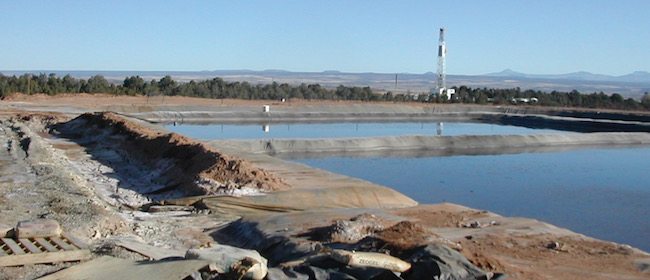We’re all pretty aware these days that fracking requires ludicrous amounts of water mixed with nasty chemicals. And that the huge boom in drilling over the last decade was largely fueled by new fracking technologies. There has been a lot of discussion about the environmental impacts of the fracking process itself, but the toxic waste that results is often overlooked.
In fact, despite the EPA acknowledging in 1988 that generic Resource Conservation and Recovery Act (RCRA) Subtitle D provisions for non-hazardous waste were inadequate, outdated and in need of updates to protect against potential harm to human health, the EPA STILL has not acted. Moreover, Congress mandated that they review and revise regulations at least every three years in order to stay up to date with changes to industry practices and understanding of risks to human and environmental health related to that waste. Again, no action.
While the EPA looked the other way over these last decades, the oil and gas industry was transformed by advancements in horizontal drilling and advanced fracking techniques. The result was a fracking boom in the last decade that drastically reduced the need for imports and sent prices downward. We’re not sure how they didn’t notice.
And with all those advancements, the waste that resulted grew larger and more toxic. Today, waste from oil and gas operations contain known carcinogens, toxic metals and radioactive materials. How are they treated? As if they weren’t toxic at all – sprayed on roads and into the air, sent to standard landfills not designed for toxic waste and injected back into the ground where it threatens our drinking water and is now known to cause earthquakes.
And nearly three decades have slipped by without any promised review.
Today we’re taking action with our partners to force the Environmental Protection Agency into keeping its promises and fulfill its commitments to Congress to update these unacceptably outdated regulations.
They can’t keep looking in the other direction. And really, it will be hard for them to argue against us considering they agreed with us nearly 30 years ago.
The full press release is below. We’ll keep you posted on how it goes.
See legal complaint here.
Groups Sue EPA Over Dangerous Drilling and Fracking Waste
Call for Rules for Handling and Disposal of Oil and Gas Waste to Prevent Earthquakes, Drinking Water Contamination
FOR IMMEDIATE RELEASE:
WASHINGTON, D.C. – A coalition of community and environmental organizations filed a federal lawsuit against the U.S. Environmental Protection Agency today calling for regulations to stop oil and gas companies from disposing and handling drilling and fracking wastes in ways that threaten public health and the environment.
The organizations are pushing EPA to issue rules that address problems including the disposal of fracking wastewater in underground injection wells, which accept hundreds of millions of gallons of oil and gas wastewater and have been linked to numerous earthquakes in Arkansas, Colorado, Kansas, New Mexico, Ohio, Oklahoma, and Texas.
“Updated rules for oil and gas wastes are almost 30 years overdue, and we need them now more than ever,” said Adam Kron, senior attorney at the Environmental Integrity Project. “Each well now generates millions of gallons of wastewater and hundreds of tons of solid wastes, and yet EPA’s inaction has kept the most basic, inadequate rules in place. The public deserves better than this.”
The groups filing today’s suit include the Environmental Integrity Project, Natural Resources Defense Council, Earthworks, Responsible Drilling Alliance, San Juan Citizens Alliance, West Virginia Surface Owners’ Rights Organization, and the Center for Health, Environment and Justice.
The lawsuit, filed in the U.S. District Court for the District of Columbia, calls on the court to set strict deadlines for EPA to comply with its long-overdue obligations to update waste disposal rules that should have been revised more than a quarter century ago.
Amy Mall, senior policy analyst at the Natural Resources Defense Council, said: “Waste from the oil and gas industry is very often toxic and should be treated that way. Right now, companies can get rid of their toxic mess in any number of dangerous ways—from spraying it on icy roads, to sending it to landfills with our everyday household trash, to injecting it underground where it can endanger drinking water and trigger earthquakes. EPA must step in and protect our communities and drinking water from the carcinogens, radioactive material and other dangerous substances that go hand-in-hand with oil and gas waste.”
The organizations are urging EPA to ban the practice of spreading fracking wastewater onto roads or fields, which allows toxic pollutants to run off and contaminate streams. And EPA should require landfills and ponds that receive drilling and fracking waste to be built with adequate liners and structural integrity to prevent spills and leaks into groundwater and streams.
The groups filed a notice of their intent to sue EPA last August, warning the agency a lawsuit would follow unless it complied with its duty under the Resource Conservation and Recovery Act (RCRA) to review and revise the federal regulations and guidelines governing how oil and gas waste must be handled and disposed. RCRA requires that EPA review the regulations and state plan guidelines at least every three years and, if necessary, revise them. The agency determined in 1988 that such revisions of the regulations were necessary to address specific concerns with oil and gas wastes, yet has failed to meet its legal responsibility to act for nearly three decades.
Background
Over the last decade, the oil and gas industry’s fracking-based boom has produced a vast amount of solid and liquid waste. Each well produces millions of gallons of wastewater and hundreds of tons of drill cuttings, which contain contaminants that pose serious risks to human health. These include known carcinogens such as benzene, toxic metals such as mercury, and radioactive materials. However, the current RCRA rules that govern oil and gas wastes are too weak because they are the same rules that apply to all “non-hazardous” wastes, including household trash.
As a result, oil and gas companies are disposing, storing, transporting, and handling these wastes in a number of troublesome ways. These include: spraying fracking waste fluids onto roads and land near where people live and work; disposing of billions of gallons of oil and gas wastewater in underground injection wells; sending the drill cuttings and fracking sands to landfills not designed to handle toxic or radioactive materials; and storing and disposing of wastewater in pits and ponds, which often leak. Across the U.S., there are numerous instances of wastes leaking out of ponds and pits into nearby streams and the groundwater beneath, and operators often “close” the pits by simply burying the wastes on site.
Aaron Mintzes, Policy Advocate for Earthworks, said: “In 1988, EPA promised to require oil and gas companies to handle this waste more carefully. Yet neither EPA nor the states have acted. Today’s suit just says 28 years is too long for communities to wait for protections from this industry’s hazardous waste.”
The following are some examples of problems caused by the improper disposal and handling of fracking and drilling waste:
- Ohio: Underground injection wells in Ohio accepted 1.2 billion gallons of oil and gas wastewater for disposal in 2015, more than double the amount in 2011. Half this wastewater came from out of state. This has resulted in scores of earthquakes in the well-dense Youngstown area, with one well alone linked to 77 earthquakes. The Ohio Oil and Gas Commission has stated that regulations “have not kept pace” with the problem and that (to an extent) both the state and industry are “working with their eyes closed.” Other states that have experienced increased seismic events in the proximity of injection wells include Alabama, Arkansas, Colorado, Kansas, New Mexico, Oklahoma, and Texas.
- Pennsylvania: In May 2012, a six-million-gallon industrial pond holding fracking wastewater in Tioga County leaked pollutants, including arsenic and strontium, through holes in its liner into groundwater and a nearby trout stream.
- West Virginia: Oil and gas wastewater dumped or spilled in rivers in West Virginia and Pennsylvania contains high levels of potentially hazardous ammonium and iodide, according to a study by Duke University scientists.
- North Dakota: In January 2015, three million gallons of drilling wastewater spilled from a leaky pipe outside Williston, polluting a tributary of the Missouri River. In July 2011, a pipeline serving a well in Bottineau County leaked over two million gallons of fracking wastewater, damaging 24 acres of private land.
- Colorado: A contractor for a pipeline services firm gave a detailed account of sand-blasting pulverized waste buildup (called “scale”) from pipeline seals directly into the air outdoors without a filter, even though such dust can be radioactive and cause damage to lungs.
- Across the Marcellus region: Over the past several years, landfills in states around the Marcellus shale formation—even in New York, where fracking is prohibited—have experienced increasing shipments of drill cuttings that contain high levels of radiation. Many of the landfills do not test for radiation and do not have adequate controls to prevent the often toxic and radioactive “leachate” from seeping into groundwater.
Julie Archer, project manager at the West Virginia Surface Owners’ Rights Organization, said: “Although West Virginia has taken some steps to improve regulation, the state’s approach has been to permit horizontal drilling without carefully considering whether current methods of waste disposal are appropriate or adequate. It’s past time for the EPA to provide clear guidance on how these wastes should be handled to protect our communities.”
Teresa Mills, director of the Ohio field office for the Center for Health, Environment and Justice, said: “A major reason for the industry’s use of injection wells to dispose of toxic fracking waste is the low disposal cost. We reject this reasoning because the public’s health and safety must come first.”
EPA’s current regulations do not take into account the dangerous contents of oil and gas wastes or their unique handling and disposal practices. Since 1988, the agency has acknowledged the shortcoming of its basic rules for solid waste management and has indicated that it needs to create enhanced rules tailored to the oil and gas industry. However, the agency has yet to take any action to develop these updated regulations.
Dan Olson, Executive Director of the Colorado-based San Juan Citizens Alliance, said: “As an organization representing hundreds of families living in close proximity to oil and gas operations, we see not only the physical pollution, but also the psychological toll that oil and gas waste exacts on communities. That the EPA is 30 years overdue in creating common sense rules for managing toxic waste from oil and gas operations is a cause of great concern for everyone living near these sources of improperly regulated industrial pollution.”
CONTACT:
Tom Pelton, Environmental Integrity Project, 202-888-2703 or tpelton@environmentalintegrity.org
Kate Kiely, NRDC, 212-727-4592 or kkiely@nrdc.org




It’s pretty clear that fracking is damaging our environment, health, and quality of life. At he very LEAST, we need common sense rules and guidelines.
We are living in the 21st century and need to stop reckless requirements for handling solution from industrial wastes such as wastes and pollution from fracking.
It is ludicrous to me that the EPA has done nothing in 30 years, and also points in the direction of political pressure. A law suit is definitely in order as there is no doubt in my mine that the the energy industry has purchased some of our legislators to pressure the EPA into doing nothing.
We have much proof of the lack of trust worthiness in the energy industry going all the way back to the Exon Valdez. Stench attracts stench, and there are neanderthal minded, climate change denying, legislators for sale to the highest paying energy lobbyist who will do the bidding of that special interest group no matter the cost, health included, to their constituents.